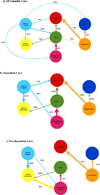Differential reward network functional connectivity in cannabis dependent and non-dependent users
- PMID: 24838032
- PMCID: PMC4349558
- DOI: 10.1016/j.drugalcdep.2014.04.002
Differential reward network functional connectivity in cannabis dependent and non-dependent users
Abstract
Background: Emergent studies show that similar to other substances of abuse, cue-reactivity to cannabis is also associated with neural response in the brain's reward pathway (Filbey et al., 2009). However, the inter-relatedness of brain regions during cue-reactivity in cannabis users remains unknown.
Methods: In this study, we conducted a series of investigations to determine functional connectivity during cue-reactivity in 71 cannabis users. First, we used psychophysiological interaction (PPI) analysis to examine coherent neural response to cannabis cues. Second, we evaluated whether these patterns of network functional connectivity differentiated dependent and non-dependent users. Finally, as an exploratory analysis, we determined the directionality of these connections via Granger connectivity analyses.
Results: PPI analyses showed reward network functional connectivity with the nucleus accumbens (NAc) seed region during cue exposure. Between-group contrasts found differential effects of dependence status. Dependent users (N=31) had greater functional connectivity with amygdala and anterior cingulate gyrus (ACG) seeds while the non-dependent users (N=24) had greater functional connectivity with the NAc, orbitofrontal cortex (OFC) and hippocampus seeds. Granger analyses showed that hippocampal and ACG activation preceded neural response in reward areas.
Conclusions: Both PPI and Granger analyses demonstrated strong functional coherence in reward regions during exposure to cannabis cues in current cannabis users. Functional connectivity (but not regional activation) in the reward network differentiated dependent from non-dependent cannabis users. Our findings suggest that repeated cannabis exposure causes observable changes in functional connectivity in the reward network and should be considered in intervention strategies.
Keywords: Craving; Cue-reactivity; Granger; Marijuana; PPI; Ventral striatum.
Copyright © 2014 Elsevier Ireland Ltd. All rights reserved.
Conflict of interest statement
Conflict of interest statement
The authors do not have any conflict of interest to disclose.
Figures





References
Publication types
MeSH terms
Grants and funding
LinkOut - more resources
Full Text Sources
Other Literature Sources
Medical

